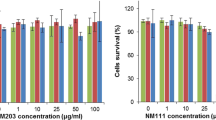Abstract
In this paper the fate (as size and surface charge changes) of Stöber silica based nanoparticles in contact with a growth medium is studied through dynamic light scattering (DLS), ζ-potential analyser and electronic microscopy, both scanning (SEM) and transmission (TEM). The experimental results confirm that biomacromolecules corona rapidly forms on NP incubated after dispersion in biological environments. They also suggest that: interactions with the components of the growth media may reverse the Stöber particles aggregation process, giving smaller disaggregated particles bringing a biomacromolecules corona. At longer incubation time the particles slightly grow because of biomacromolecules interlocking. Incubation temperature and growth medium concentrations strongly affect the nanoparticles fate. In fact overnight incubation at 4 °C of particles dispersed into reconstituted EPILIFE growth medium diluted with water in a ratio 50/50 produces a corona compositionally and/or structurally different than the one formed during incubation at 37 °C of particles dispersed into reconstituted EPILIFE. However when the first ones are redispersed into reconstituted EPILIFE and incubated at 37 °C a change in the corona composition/structure does occur; at long times particles are obtained of similar hydrodynamic radius and ζ-potential than the ones produced after direct dispersion into reconstituted EPILIFE and incubation at 37 °C. DLS and ζ-potential measurements appear to be valuable tools to study the fate of nanoparticles in biological environments with the further advantage, with respect to SEM and TEM, that the nanoparticles are not exposed to the risk of clustering during samples preparation because of solvent evaporation.








Similar content being viewed by others
References
Fenoglio I, Fubini B, Ghibaudi EM, Turci F (2011) Multiple aspects of the interaction of biomacromolecules with inorganic surfaces. Adv Drug Deliver Rev 63:1186–1209
Walczyk D, Bombelli FB, Monopoli MP, Lynch I, Dawson KA (2010) What the cell “sees” in bionanoscience. J Am Chem Soc 132:5761–5768
Lynch I, Cedervall T, Lundqvist M, Cabaleiro-Lago C, Linse S, Dawson KA (2007) The nanoparticle–protein complex as a biological entity; a complex fluids and surface science challenge for the 21st century. Adv Colloid Interface 134–35:167–174
Lynch I, Dawson KA (2008) Protein–nanoparticle interactions. Nano Today 3:40–47
Walkey CD, Olsen JB, Song F, Liu R et al (2014) Protein corona fingerprinting predicts the cellular Interaction of gold and silver nanoparticles. ACS Nano 8:2439–2455
Branda F, Silvestri B, Luciani A, Costantini A (2007) The effect of mixing alkoxides on the Stöber particles size. Colloid Surface A 299:252–255
Stöber W, Fink A (1968) Controlled growth of monodisperse silica spheres in the micron size range. J Colloid Interface Sci 26:62–69
Bogush GH, Tracy MA, Zukosky CF (1988) Preparation of monodisperse silica particles: control of size and mass fraction. J Non Cryst Solids 104:95–106
Bogush GH, Zukosky CF (1991) Uniform silica particle precipitation: an aggregation growth model. J Colloid Interface Sci 142:19–34
Lee K, Sathyagal AN, McCormick AV (1998) A closer look at an aggregation model of the Stöber process. Colloids Surf A 144:115–125
Soto-Cantu E, Cueto R, Koch J, Russo PS (2012) Synthesis and rapid characterization of amine-functionalized silica. Langmuir 28:5562–5569
Barral S, Villa-Garcıa MA, Rendueles M, Dıaz M (2008) Interactions between whey proteins and kaolinite surfaces. Acta Mater 56(12):2784–2790
Hill HD, Hurst SJ, Mirkin CA (2009) Curvature-induced base pair “slipping” effect in DNA-nanoparticle hybridization. Nano Lett 9:317–321
Cederquist KB, Keating CD (2009) Curvature effects in DNA: au nanoparticle conjugates. ACS Nano 3:256–260
Branda F, Silvestri B, Luciani G, Costantini A, Tescione F (2010) Synthesis structure and stability of amino functionalized PEGylated silica nanoparticles. Colloids Surf A 367:12–16
Gao GM, Zou HF, Liu DR et al (2009) Influence of surfactant surface coverage and aging time on physical properties of silica nanoparticles. Colloids Surf A 350:33–37
Pan H, Qin M, Meng W, Cao Y, Wang W (2012) How do proteins unfold upon adsorption on nanoparticle surfaces? Langmuir 28:12779–12787
Lundqvist M, Sethson I, Jonsson BH (2004) Protein adsorption onto silica nanoparticles: conformational changes depend on the particles’ curvature and the protein stability. Langmuir 20:10639–10647
Asuri P, Bale SS, Karajanagi SS, Kane RS (2006) The protein–nanomaterial interface. Curr Opin Biotech 17:562–568
Denis FA, Pallandre A, Nysten B, Jonas AM, Dupont-Gillain CC (2005) Alignment and assembly of adsorbed collagen molecules induced by anisotropic chemical nanopatterns. Small 1:984–991
Roach P, Farrar D, Perry CC (2006) Surface tailoring for controlled protein adsorption: effect of topography at the nanometer scale and chemistry. J Am Chem Soc 128:3939–3945
Author information
Authors and Affiliations
Corresponding author
Rights and permissions
About this article
Cite this article
Branda, F., Silvestri, B., Costantini, A. et al. Effect of exposure to growth media on size and surface charge of silica based Stöber nanoparticles: a DLS and ζ-potential study. J Sol-Gel Sci Technol 73, 54–61 (2015). https://doi.org/10.1007/s10971-014-3494-2
Received:
Accepted:
Published:
Issue Date:
DOI: https://doi.org/10.1007/s10971-014-3494-2




